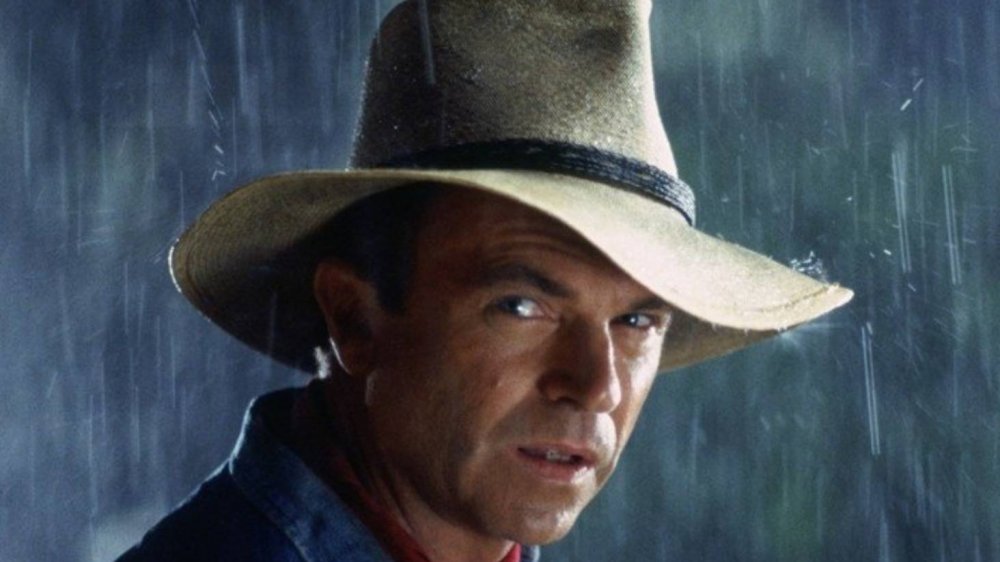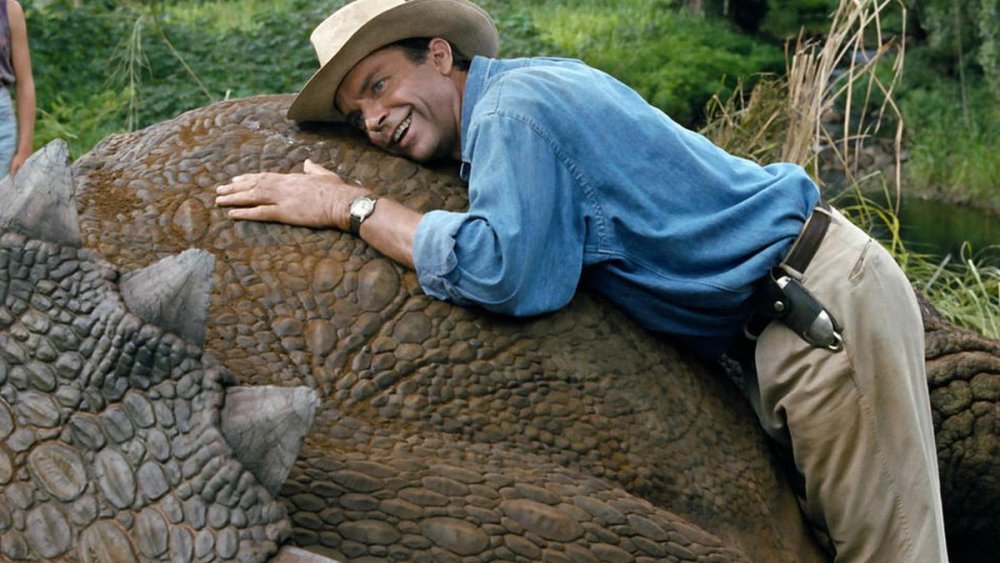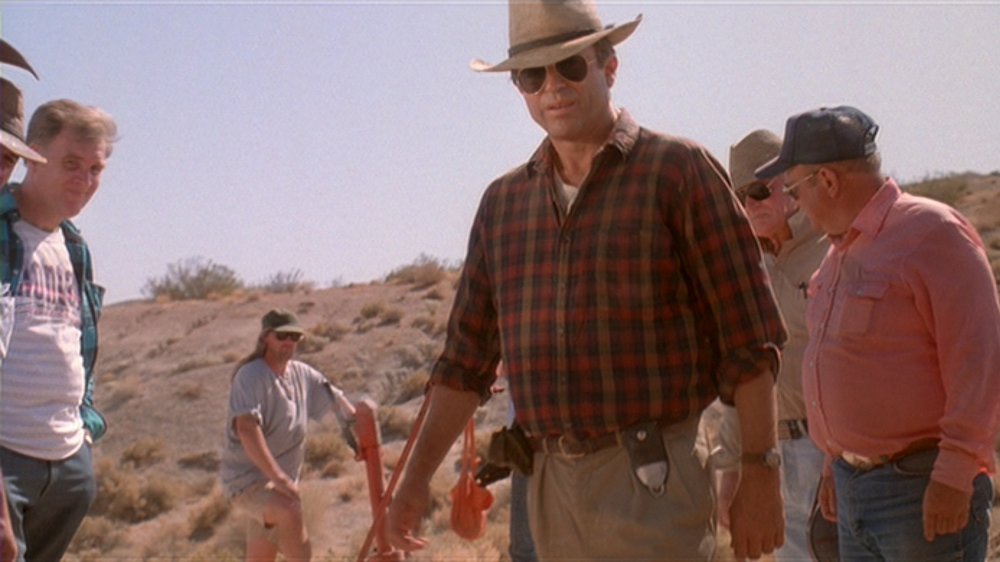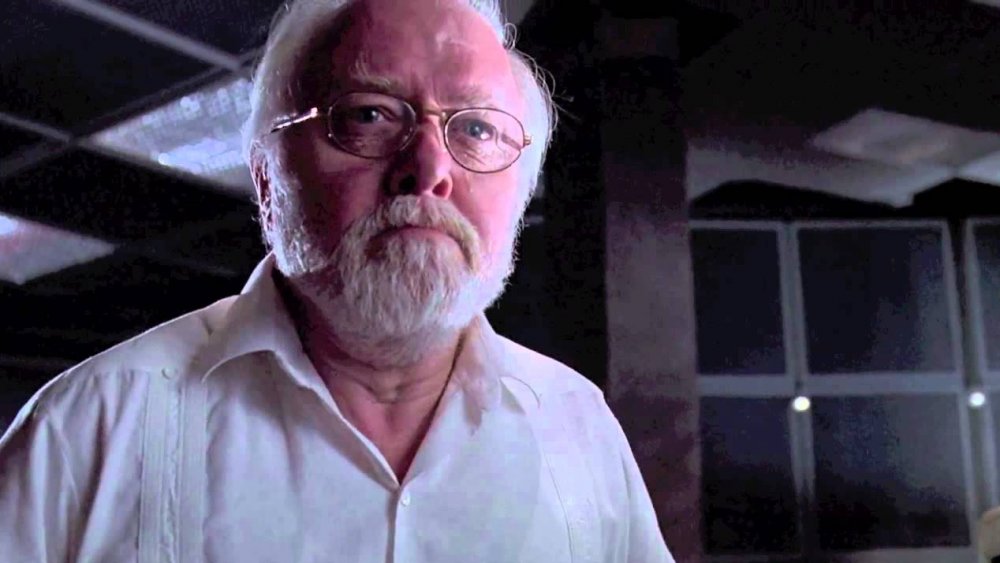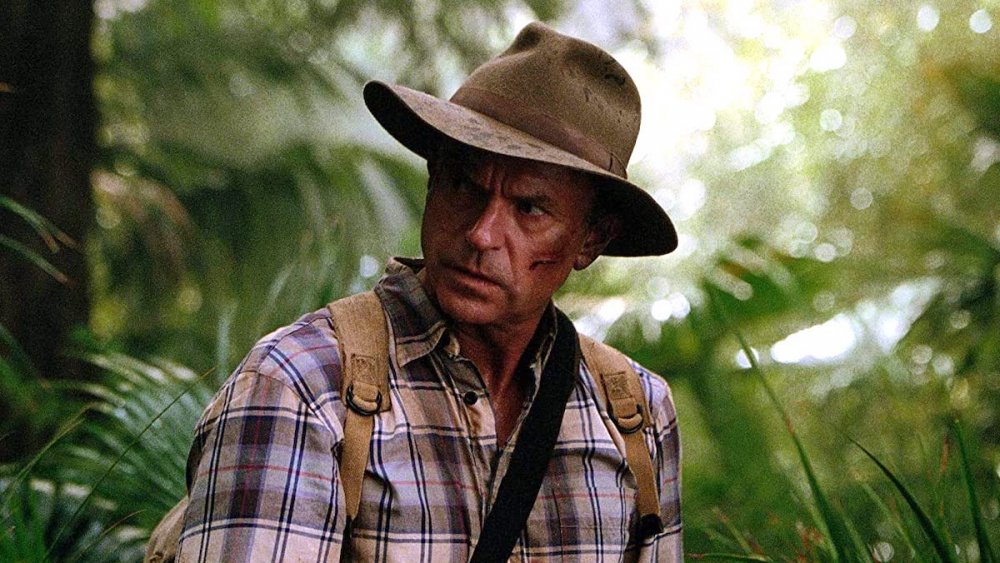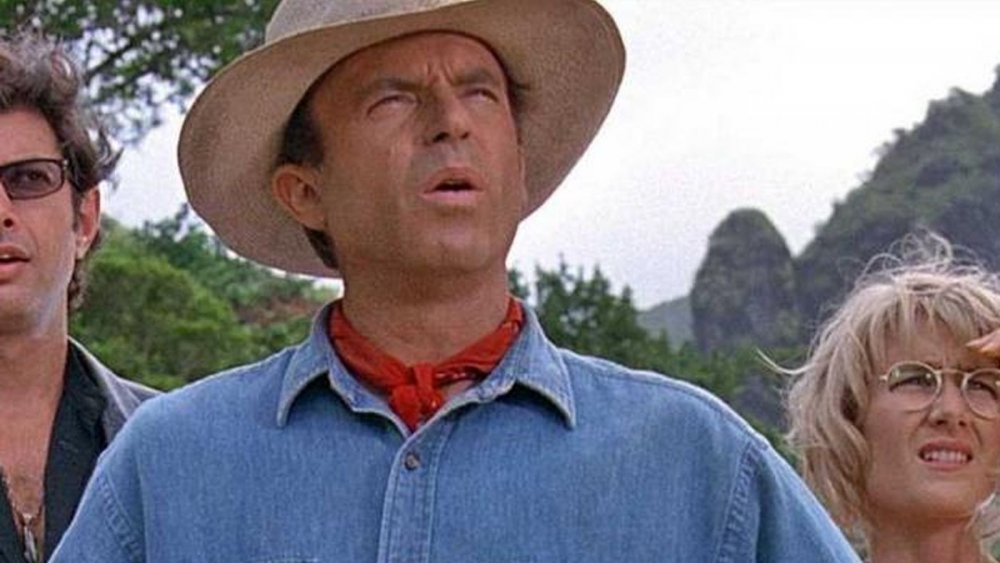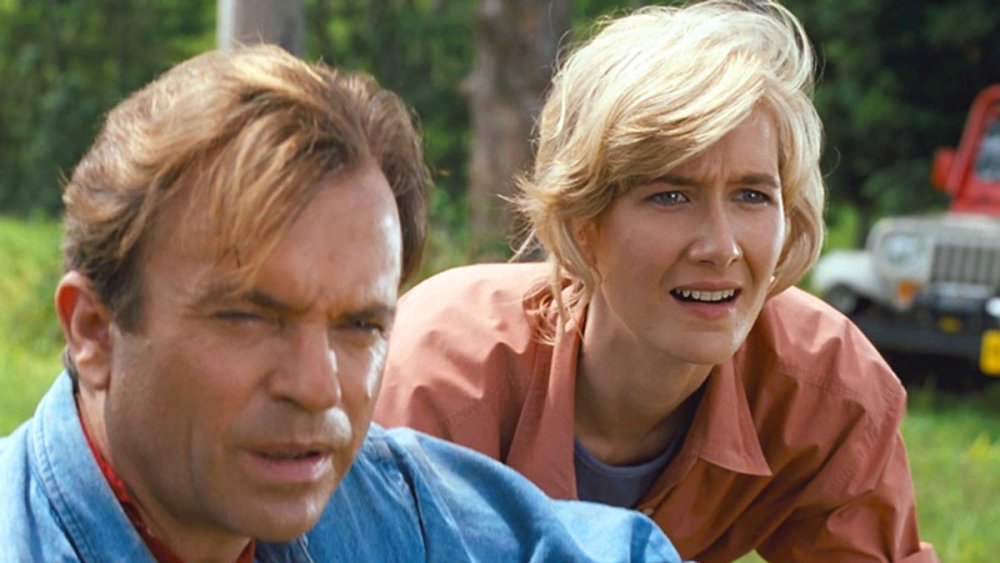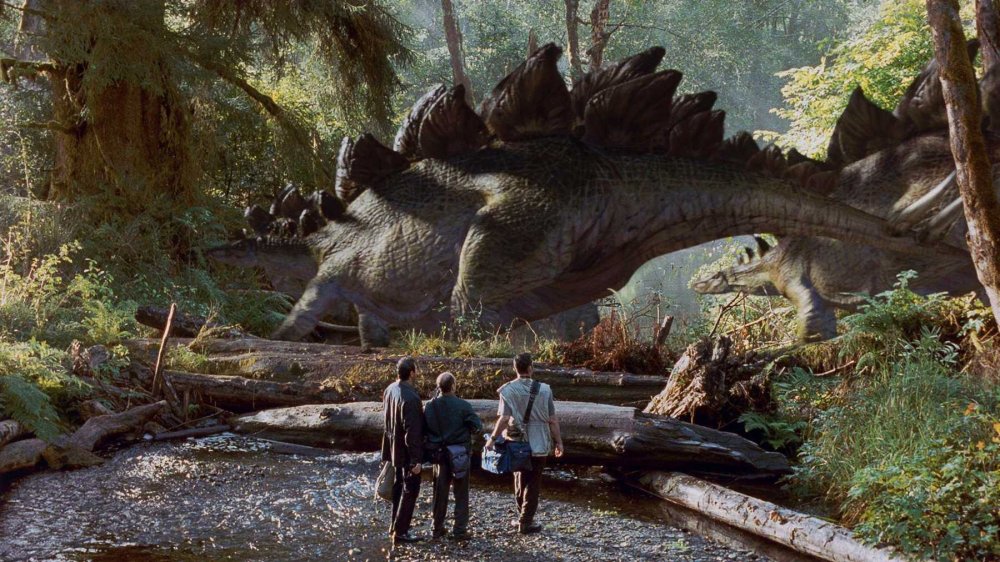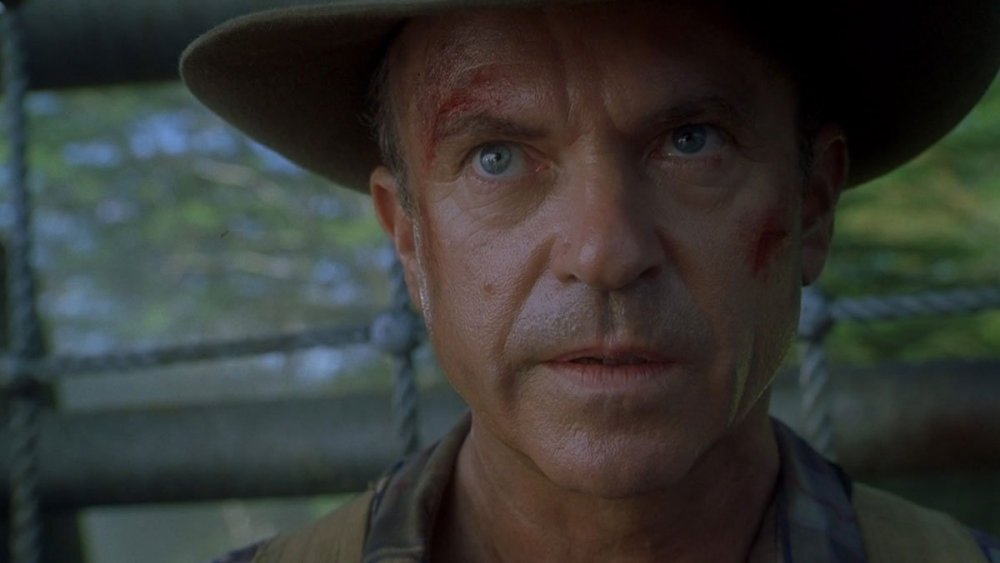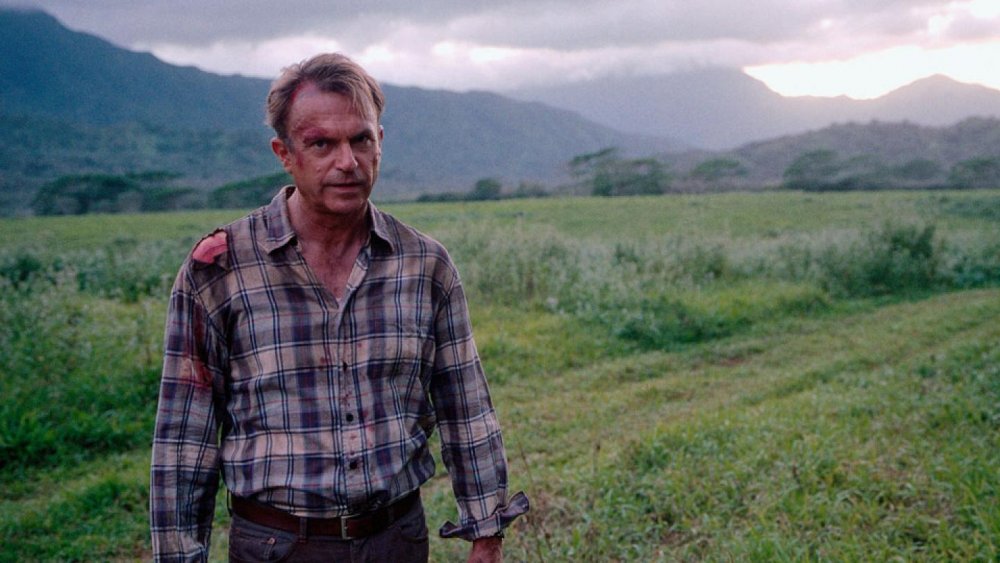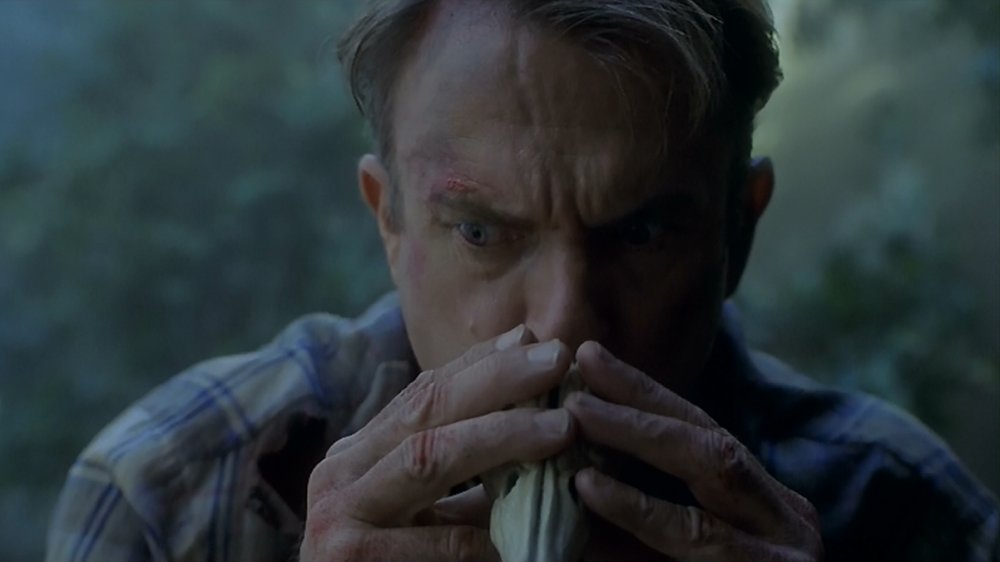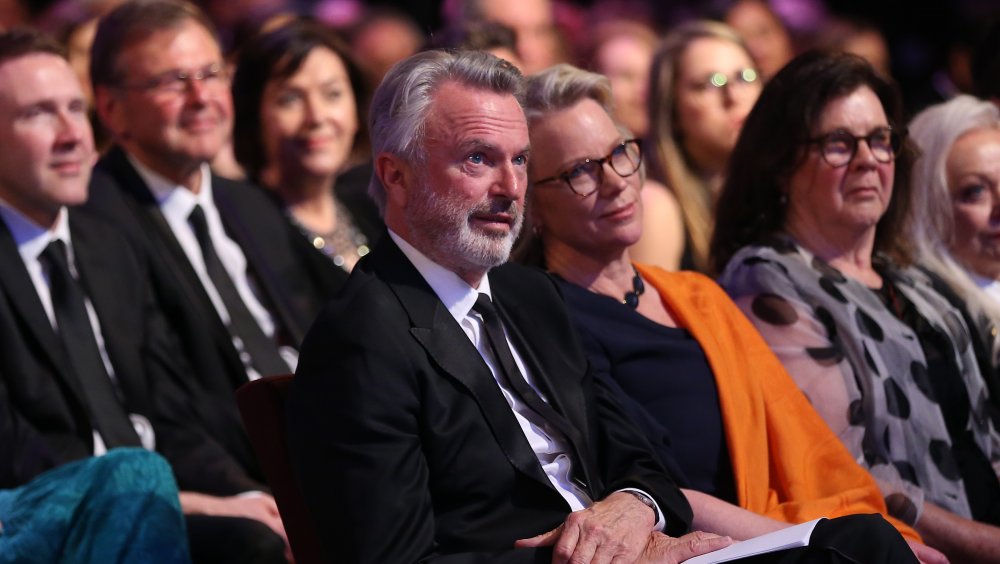Dr. Grant's Entire Jurassic Park Backstory Explained
It's not revolutionary to say that Jurassic Park movies live or die by their dinosaurs. It's the first world in the title and about 90 percent of the series' iconic logo. The dinos get pre-release buzz and butts in seats. Jurassic Park isn't a feature-length shot of a robot dinosaur wreaking havoc, though.
While the practical effects employed by Steven Spielberg and his crew for the original film were groundbreaking, they didn't reinvent the wheel when it came time to tell their story. The narrative of Jurassic Park centers around one man, a cynic who we have to empathize with to bring us into the world and make us believe it. Dr. Alan Grant's initial derision turns to wide-eyed wonderment and all-consuming fear along with the audience. And for that old trick to work, we have to like him a little bit.
Luckily, author Michael Crichton and the screenwriters of Jurassic Park knew this, creating an iconic character that could explain the science of the miraculous work being done inside the park — and react accordingly when it all went wrong.
A font of dinosaur knowledge
In both the novel and the film version of Jurassic Park, Dr. Grant is the source of dinosaur-related exposition. He starts the movie with a monologue about the dangers of sharp-clawed, pack-hunting dinosaurs, frightening a small child who took their deadliness for granted (and foreshadowing the events of the story). In explaining the terror of a prehistoric monster that a kid calls a "six-foot turkey," Grant establishes himself as the one in the room that's taking the danger of dinosaurs seriously.
"He moves like a bird, lightly, bobbing his head. And you keep still because you think that maybe his visual acuity is based on movement like T-Rex — he'll lose you if you don't move. But no, not Velociraptor. You stare at him, and he just stares right back. And that's when the attack comes. Not from the front, but from the side, from the other two raptors you didn't even know were there," he explains to an ever-more-uncomfortable visitor at his dig site. "He slashes at you... across the belly, spilling your intestines. The point is, you are alive when they start to eat you. So, you know, try to show a little respect."
Grant's explanations of what velociraptors and T. Rexes are might seem a bit superfluous after five movies and decades of soaking in dino knowledge, but it was necessary at the time. The public conception of dinosaurs, and boom in interest in the study of paleontology, can be directly linked to the popularity of Crichton's book and Spielberg's movie. Every '90s kid grew up with visions of brontosauruses in their heads, but those images were planted by animatronic creatures that stomped through Spielberg's frame while a slack-jawed Sam Neill looked on.
A working paleontologist
Even if the audience needs an authority figure to tell them what they're looking at when the dinosaurs come around, nobody likes to be lectured. To get around this, Crichton made Grant much more likable to the average reader by bringing him down out of the academic ivory tower and placing him in the Montana dirt. Though Grant is a world-renowned expert on dinosaur nests, he's equally at home in or outside the lecture hall.
The Grant of both the book and the movie is shown as a working man who prefers being on a dig site to writing up a paper on his findings. In the novel, he makes his feelings about his fellow academics clear and notes that he sees himself as a Joe Lunchbucket type who just happens to work in science. The movie drives this home by introducing him in a dusty landscape in Snakewater, Montana with a fresh layer of grime on his clothes. Spielberg wants the audience to know that Grant's come by his expertise honestly via real hands-on work in the hot sun and that he's not here to read passages from a 19th century naturalist in a haughty tone.
Last ditch effort
Jurassic Park founder and CEO Doctor John Hammond tracks Grant down and invites him to his latest venture, a park full of cloned dinosaurs off the coast of Costa Rica. The park is in jeopardy of never opening, as a park employee was killed by one of the genetically engineered velociraptors set to be on display at the island-sized zoo. Hammond hopes that he can get the seal of approval from all parties involved, staving off a crisis of investors fleeing the project.
Grant feels compelled to go, as Hammond is funding his current dig. He comes along with his paleobotanist partner Ellie Sattler, joining Hammond, his attorney, and chaos theorist Ian Malcolm for a preview of the park. If the dinosaur experts rule that the attractions are safe, the chaos theorist rules that they've done everything possible to stave off a breakdown, and the lawyer feels that Hammond isn't setting himself up for disaster, then the park can go ahead with its planned opening.
A split characterization
In the movie, Dr. Grant is very wary of children. Part of the movie's charm is the way it shows the hard-edged and science-driven Grant warming to Hammond's grandchildren over time. Sam Neill initially plays the character as a prickly child hater, standing in for a certain audience reaction to precocious children and the complications they can cause in a park filled with dinosaurs.
On the contrary, the book's version of Dr. Grant is instantly taken with Hammond's grandchildren. In fact, this was the point of Hammond bringing them along for the test run of the park in the first place. He hoped that seeing the awe and joy that the dinosaurs brought to children would dull the edges of the scientist's critiques, as they wouldn't want to be spoilsports. Dr. Grant in the novel sees the potential for another excitable and hardworking paleontologist in Tim, a self-styled expert on dinosaurs who has the tireless energy of obsessed kids everywhere.
Regardless of his initial feelings, in both versions of the story Grant becomes a protector of Hammond's grandchildren as they attempt to escape the park alive.
By the skin of their teeth
After a helicopter ride during which Malcolm shares why he believes the park will fall into chaos, Grant is wowed by a drive into the park where they encounter the first living, breathing Brachiosaurus in millions of years. Hammond strikes while the awe iron is hot, taking the paleontologist to a presentation that reveals the way his team was able to clone dinosaurs in the first place.
Park scientists extracted dinosaur DNA from prehistoric mosquitoes trapped in amber and filled in the gaps of dinosaurs' genetic code using frog DNA, after which the genetic material was deposited into unfertilized eggs and allowed to grow and hatch. To get around the worry of dinosaur population growth straining the park's containment infrastructure, the geneticists made all of the dinosaurs female and further sterilized them with X-rays.
After they take in the scene inside the park's labs, Grant decides he wants to see one of the most dangerous species on the entire island. If the park is truly going to be safe, it needs to control its raptors. He's especially curious about the moves they've made following a death from a raptor on the island. After learning that the raptor population has dwindled as the dinosaurs fought among themselves, and seeing the remaining velociraptors tear into a cow, the group breaks for lunch and shares its opinions on the park so far.
A revered, if under-celebrated, expert
The tides of opinion aren't in Hammond's favor. Ian questions whether it's ethical to bring an extinct animal back to life, while both of the paleontologists worry that there could be unforeseen problems with remaking dinosaurs. They have no idea how right they are.
Dr. Grant has the misfortune of visiting the park while a disgruntled employee of Hammond's is hoping to pull off a heist of Jurassic Park's most valuable assets: the dinosaur embryos. He hopes to wait for a moment of vulnerability and shut down the security system, which arrives while Grant and the rest of the inspection team are on the island.
After an uneventful tour during which none of the dinosaurs on display cooperate, a storm lays into the island. When the employees of the park leave due to the monsoon, the scheming employee shuts down the electrical grid so he can access the embryos. Unfortunately, this also shuts off the electrified fences and other gates used to hold in the park's more dangerous dinosaurs. The resulting darkness and storm strand Dr. Grant with Hammond's grandchildren as a T. Rex breaks out of its containment.
Grant is forced to face down several free-roaming megapredators, including a hungry Tyrannosaurus rex that attacks the group's disabled Jeep. While fleeing the unleashed monsters, Grant stumbles upon a nest of eggs (something that shouldn't be possible).
They determine that the dinosaurs were able to switch sexes, as some frogs are able to do in the absence of male or female partners. Meanwhile, just about every system imaginable is breaking down inside the park.
A further shutdown of the park's systems to fix the issues implanted by the programmer frees the velociraptors, who trap Hammond's grandchildren in a kitchen. They are able to escape and meet up with Grant before all three of them are cornered by a loose T. Rex. The dinosaur is distracted by the pack of raptors and the trio flee to safety. Hammond reconnects with Grant and his family and they flee the island on a helicopter.
Given how catastrophic his first experience with living dinosaurs was, it's no surprise that Alan Grant is not around for the second Jurassic Park adventure, The Lost World. The characters do cite Grant's writing as an authority on the subject, however.
Lost without Grant
The second attempted iteration of Jurassic Park happens without the help of Drs. Grant or Hammond. The original InGen founder and CEO stepped down after the disaster on his planned island, but his upstart nephew Peter is looking to right the ship and build a new dinosaur attraction in San Diego. Peter Hammond reaches out to Ian Malcolm and reveals that InGen had another island of dinosaurs that they used for research, and he's hoping to harvest some of these free-living dinosaurs and bring them to the Southern California park for paying customers.
This goes about as well as you might expect, with several of InGen's hired guns dying on the island in the quest to corral a T. Rex. The king of the dinosaurs is eventually herded onto a ship, but he manages to kill all the crew members before the boat crashes into a San Diego harbor. The deadly dinosaur rampages through the city in search of an infant T. Rex that had been taken from it, but the dinosaurs are eventually captured and returned to Isla Sorna, where Hammond pleads that humanity leave them alone.
Troubled relationship with dinos
As you might expect, Grant's relationship to dinosaurs changes significantly after nearly losing his life several times over in Jurassic Park. He's deeply traumatized by his in-person encounters with the great beasts, to the point that it begins to affect his work. Though Grant can't quite shake the field he's dedicated his entire life to studying, the Grant that audiences are introduced to in the third Jurassic Park movie seems to want to have as little to do with dinosaurs as his job as a paleontologist allows.
In particular, Grant is deeply disdainful of the cloned dinosaurs created by Dr. Hammond and his lackeys. He calls them monsters and freaks to anyone who will listen as he toils on sites that are suffering from a lack of interest in fossils. His professional life is further hindered by the people who want to hear about what he went through at the original Jurassic Park. If his lectures are attended at all, they're often full of people who want to hear about the worst day of his life.
Shanghaied
Eventually, economic realities force Grant to take a job that will bring him into the proximity of a dinosaur park. A wealthy couple convinces Dr. Grant to do a fly-over of Isla Sorna to provide his expertise about what they are looking at. As they get near the island, it becomes clear that the couple had no intention of letting Grant just glance at the situation. The helicopter begins to lower as henchman knock Grant unconscious.
When he wakes up, he's been stranded on the island. Grant, along with his new dig partner Billy and the wealthy couple, begin to scour their new surroundings. The couple had hired Grant believing he knew the island — knowledge they were hoping to use because their son Eric had disappeared while visiting two months prior. An illegal paragliding operation that gave tours of the off-limits island brought their son over the park when his rigging broke and he was left behind on Isla Sorna.
Grant is entirely unfamiliar with the island, however, as it's different from the one on which the original Jurassic Park was built. Stuck there anyway, the group carris on with their search, finding the corpse of someone who was traveling with Eric. After several encounters with raptors, Grant finds Eric hiding out in an overturned supply truck on the largely abandoned island.
Escaping Isla Sorna
After several more attacks, Grant learns that his site manager Billy Brennan, who helped convince him to take the trip in the first place and ended up coming along, stole several dinosaur eggs in the hopes of securing funding for further study when they left the island. As velociraptors are highly territorial pack-hunting animals, the raptors begin tracking the eggs down and attacking the group.
After Billy is wounded, Grant takes the eggs and uses them to lay a trap for the raptors. He surrenders the eggs to the animals and then uses a faux-raptor larynx to frighten them away, after which the group uses a satellite phone to call Grant's former partner Ellie in the hopes that she can rouse the Navy. When they make it to the coast, they find that their plans worked and escape the island on a military vessel. Though several other Jurassic Park movies have been made (with ever more complicated justifications for new parks), Grant largely drops off the radar following his second brush with real-life dinosaurs. Though you might expect him to be a broken man at this point, seeing the dinosauars up close merely reinvigorates his desire to study the ancient creatures. Having experienced the way the velociraptors hunt from the other end, his need to know more about them only increases.
All that aside, he seems happy to do his investigating on dead dinosaurs from dig sites, leaving the later parks to other people.
The return
Grant couldn't stay away from the dinosaurs forever, though. Two more trips to ill-fated parks have come and gone since Dr. Grant hung up his famous hat. But he's putting it back on for the upcoming film Jurassic World: Dominion. Actor Sam Neill broke the news to the Jurassic faithful when he posted on Twitter that he'd begun filming a reprisal of his famous role.
"Hold onto your hat. Getting my old one back this week, and facing off dinosaurs once again. Best yet," he said. "Excited and terrified — these things will kill ya."
Neill noted that a lot has changed since his first time in the role, joking that he's a lot more "grizzled" than the man who first set foot in Jurassic Park. But other things won't change one bit. He posted a photo of his iconic hat from the set of the movie, saying "Hello, old friend." And his tags indicate that Laura Dern will also be returning to the lost world, taking up her role of Ellie.
